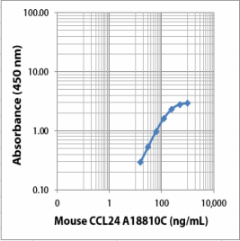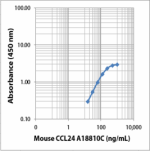- Clone
- A18110C (See other available formats)
- Regulatory Status
- RUO
- Other Names
- MPIF-2
- Isotype
- Rat IgG1, κ
- Ave. Rating
- Submit a Review
- Product Citations
- publications

-

Direct ELISA showing purified anti-mouse CCL24 (clone A18110C) bound to plate-immobilized recombinant mouse CCL24 protein (Cat. No. 585102). The wells were incubated with serially diluted primary antibody at room temperature for 2 hours in 1% BSA-PBS, followed by incubation with HRP Goat anti-rat IgG (Cat. No. 405405). TMB High Sensitivity Substrate Solution (Cat. No. 421501) was used for detection.
| Cat # | Size | Price | Quantity Check Availability | Save | ||
|---|---|---|---|---|---|---|
| 612752 | 100 µg | 188€ | ||||
CLL24 was initially cloned from a library of activated macrophages, and using human eosinophils, it was shown that it binds to the receptor of eotaxin-1 (CCL11) and MCP-4 (CCL13). In addition, CCL24 shares the CCR3 receptor with CCL26, CCL5, and CCL7. Eotaxin/CCR3 expression has been studied extensively in the pathogenesis of asthma and allergy. In addition, the eotaxin/CCR3 axis has been associated to additional inflammatory and autoimmune disorders including inflammatory bowel disease, multiple sclerosis, eosinophilic esophagitis, and rheumatoid arthritis. CCL24 has also been associated with neovascular age related macular degeneration.
Product DetailsProduct Details
- Verified Reactivity
- Mouse
- Antibody Type
- Monoclonal
- Host Species
- Rat
- Immunogen
- Recombinant Mouse CCL24 Protein
- Formulation
- Phosphate-buffered solution, pH 7.2, containing 0.09% sodium azide
- Preparation
- The antibody was purified by affinity chromatography.
- Concentration
- 0.5 mg/mL
- Storage & Handling
- The antibody solution should be stored undiluted between 2°C and 8°C.
- Application
-
Direct ELISA - Quality tested
- Recommended Usage
-
Each lot of this antibody is quality control tested by Direct ELISA. The optimal concentration of this reagent for the specific application and the experiment design should be established by the end-user.
- Additional Product Notes
-
This production is intended for immunoassay development on various assay platforms requiring antibody pairs. This antibody (clone A18110C) could function as a capture antibody when paired with Biotin anti-mouse CCL24 antibody (Cat. No. 612153) (clone A18110F) as the detection antibody and using Recombinant Mouse CCL24 (Eotaxin-2) protein (Cat. No. 585102) as the assay standard.
- RRID
-
AB_2941609 (BioLegend Cat. No. 612752)
Antigen Details
- Structure
- Chemokine
- Distribution
-
CCL24 is expressed by epithelial cells, airway smooth muscle cells, and vascular endothelial cells. In addition, eotaxins are produced by cells isolated by bronchial alveolar lavage, including macrophages, monocytes, basophils, eosinophils, dendritic cells, and lymphocytes.
- Function
- CCL24 chemoattracts CCR3 bearing cells such as eosinophils, mast cells, basophils, and Th2 cells that play a role in allergic disorders. IL-4 and IL-13 induce CCL11 and CCL24 in esophagus and colonic epithelial cell, and IL-13 induces the production of CCL-24 in dendritic cells and alveolar macrophages. In addition, CCL24 is induced by IL-33 in lungs, and by IL-4 and LPS in monocytes and macrophages. The expression of CCL24 by alveolar epithelial cells requires histamine and its receptor H2R.
- Interaction
- Eosinophils, mast cells, Th2 lymphocytes, basophils, human dendritic cells, synovial tissue macrophages, lung epithelial cells, and airway smooth muscle cells
- Ligand/Receptor
- CCR3
- Biology Area
- Cell Biology, Signal Transduction
- Molecular Family
- Cytokines/Chemokines
- Antigen References
-
- Patel VP, et al. 1997. J Exp. Med. 185:1163-72.
- Beaulieu S, et al. 2002. J Immunol. 169:2925-36.
- Watanabe K, et al. 2002. J Immunol. 168:1911-8.
- Ablin JN, et al. 2010. Clin Exp Immunol. 161:276-83.
- Manousou P, et al. 2010. Clin Exp Immunol. 162:337-47.
- Stolarski B, et al. 2010. J Immunol. 185:3472-80.
- Crapster-Pregont M, et al. 2012. J Allergy Clin Immunol. 129:1621-7.
- Swartzendruber JA, et al. 2012. J Immunol. 188:536-40.
- Gene ID
- 56221 View all products for this Gene ID
- UniProt
- View information about CCL24 on UniProt.org
Related FAQs
Other Formats
View All CCL24 Reagents Request Custom Conjugation| Description | Clone | Applications |
|---|---|---|
| Purified anti-mouse CCL24 | A18110C | Direct ELISA |
Compare Data Across All Formats
This data display is provided for general comparisons between formats.
Your actual data may vary due to variations in samples, target cells, instruments and their settings, staining conditions, and other factors.
If you need assistance with selecting the best format contact our expert technical support team.
-
Purified anti-mouse CCL24

Direct ELISA showing purified anti-mouse CCL24 (clone A1811...
 Login / Register
Login / Register 







Follow Us